The term ‘bottom at Christmas’ has become synonymous in the footballing world with teams fighting for their lives towards the foot of the table.
While great escapes have occurred, and the end-of-year standings are not necessarily a truly accurate measure of final league position, it paints a fascinating picture of which teams across Europe are trending towards relegation.
As for Valencia in LaLiga, a hard-fought point against Deportivo Alaves ensured they would avoid the infamous slogan and enter the winter break in 19th — crucially, an extra place above Real Valladolid on goal difference.
However, the general atmosphere around the historic and once-successful Spanish outfit is dismal at best, with fans almost accepting that there will be no way to escape the eventual drop into the Segunda División.
It matches Valencia’s structural weakness, which extends from the pitch to the top of the boardroom.
Fans are openly frustrated with how their club has been mismanaged.
The point against Alaves was not enough to save manager Rubén
Baraja’s job. After taking over in early 2023, Barajahad successfully guided the club through another tumultuous period.
Just two wins in 17 matches saw one of Valencia’s greatest legends packing his bags, with the club immediately looking overseas in search of their new successor.
Carlos Corberán returns to his boyhood club, having developed an excellent reputation through his efforts in the EFL Championship with Huddersfield and West Brom.
Valencia fans hope that Corberán can quickly instil some of the qualities that have allowed West Brom to threaten the playoffs over the past couple of seasons.
This tactical analysis will begin to highlight Valencia’s weaknesses under Baraja this season while also showcasing elements of Corberán’s tactics that could prove effective for his new team.
Valencia’s Squad Composition
For a squad that competed in the UEFA Champions League as recently as 2020, Valencia’s rapid downfall in league position and overall expectations would baffle fans who don’t necessarily pay close attention to Spanish football.
However, examining their transfer policy over the past few years would highlight a frustrating commitment to extracting profit from their most valuable assets without necessarily replacing the squad’s La Liga-level quality.
This creates a clear issue regarding the overall quality to help Valencia steer clear of the relegation zone, one which has been made apparent with multiple Valencia managers having to flirt with the threat of finishing in the bottom three.
After the 2024/25 summer window, Valencia spent around €1.35m overall, which led to another season of an under-resourced squad despite the addition of loans and free transfers.
It mirrors a trend that has seen Valencia reach a cumulative spending total of €42m over the past five seasons, with Los Ches being left in the dust by previous rivals in the pursuit of European football.
Perhaps the nail in the coffin has been the sale of star goalkeeper Giorgi Mamardashvili to Liverpool.
The meagre €30m fee appears to be significantly discounted, considering how influential the Georgian was on the club’s defensive strength.
When analysing post-shot expected goals prevented—goals conceded, Mamardashvili ranked as the third most successful keeper in Europe’s big five leagues, with a figure of +8.2, which signifies his talents between the sticks.
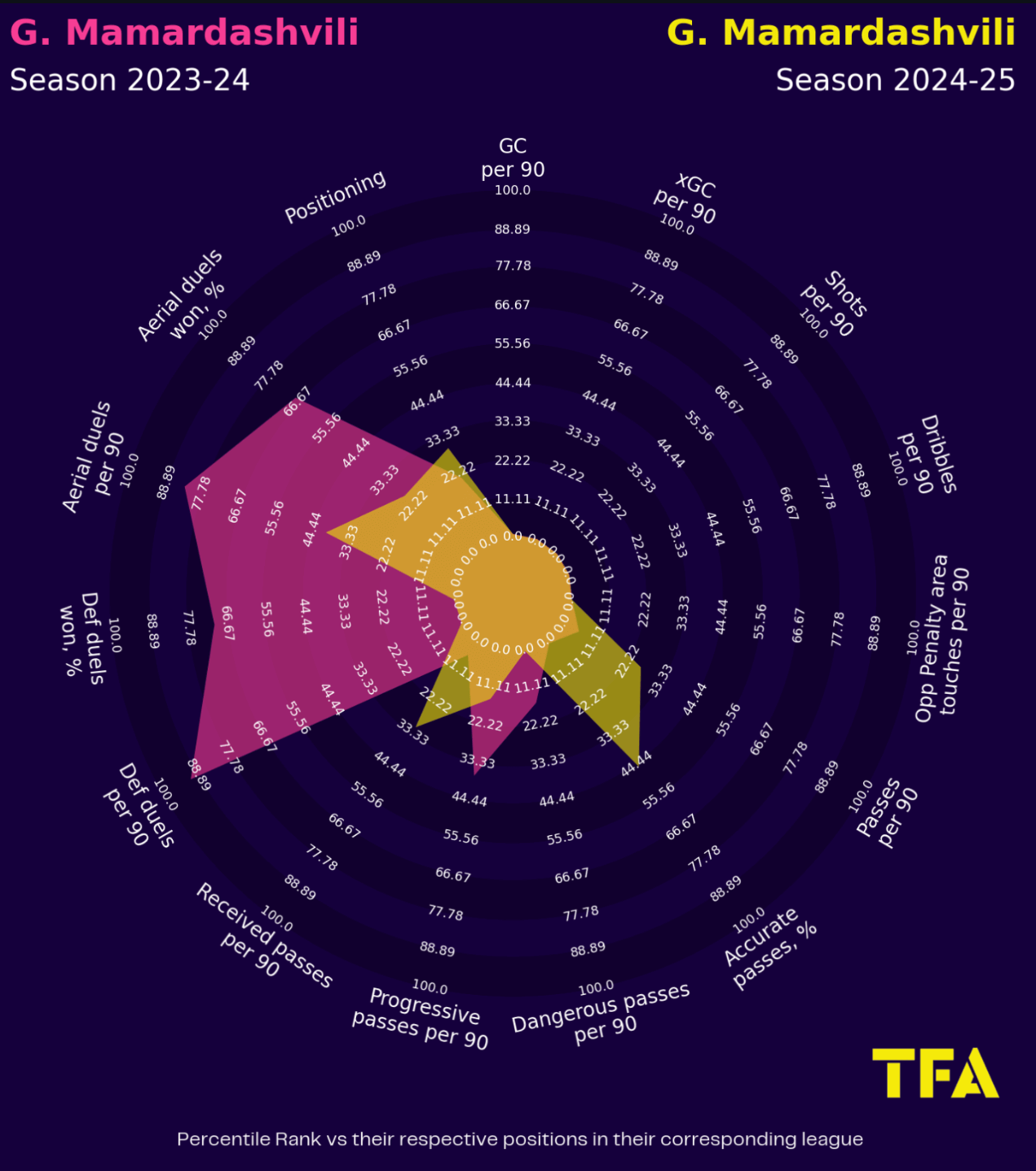
So even though Valencia were able to regain the services of Mamardashvili through a season-long loan deal, the current 2024/25 statistical figure of -0.09 would highlight the deterioration of Valencia’s defensive unit overall.
Current Defensive Frailties
Having already hired Carlos Corberán and previously requested the services of Quique Sánchez Flores, it is apparent that the Valencia hierarchy have seemingly aimed to mitigate the defensive weaknesses that have plagued their season thus far.
While previously known for a more conservative and defensively secure style when first appointed, Rubén Baraja’s Valencia side had struggled to keep the ball out of the net.
Even though individual mistakes are hard to quantify, they definitely symbolise an overall regression in Valencia’s defensive structure, often occurring as a result of their issues higher up the pitch.
Baraja’s Valencia have recorded an average ball possession of 48.9%, ranking them comfortably mid-table for that metric and highlighting their equal share between in and out-of-possession play.
The most important thing is what they do to minimise the opposition’s attacking threat, and this starts with a pressing effort which has left a lot to be desired.
Their challenge intensity of 4.7 is only 17th best in LaLiga, which indicates that their passive approach to regaining possession has exaggerated their weaknesses throughout the defensive line.
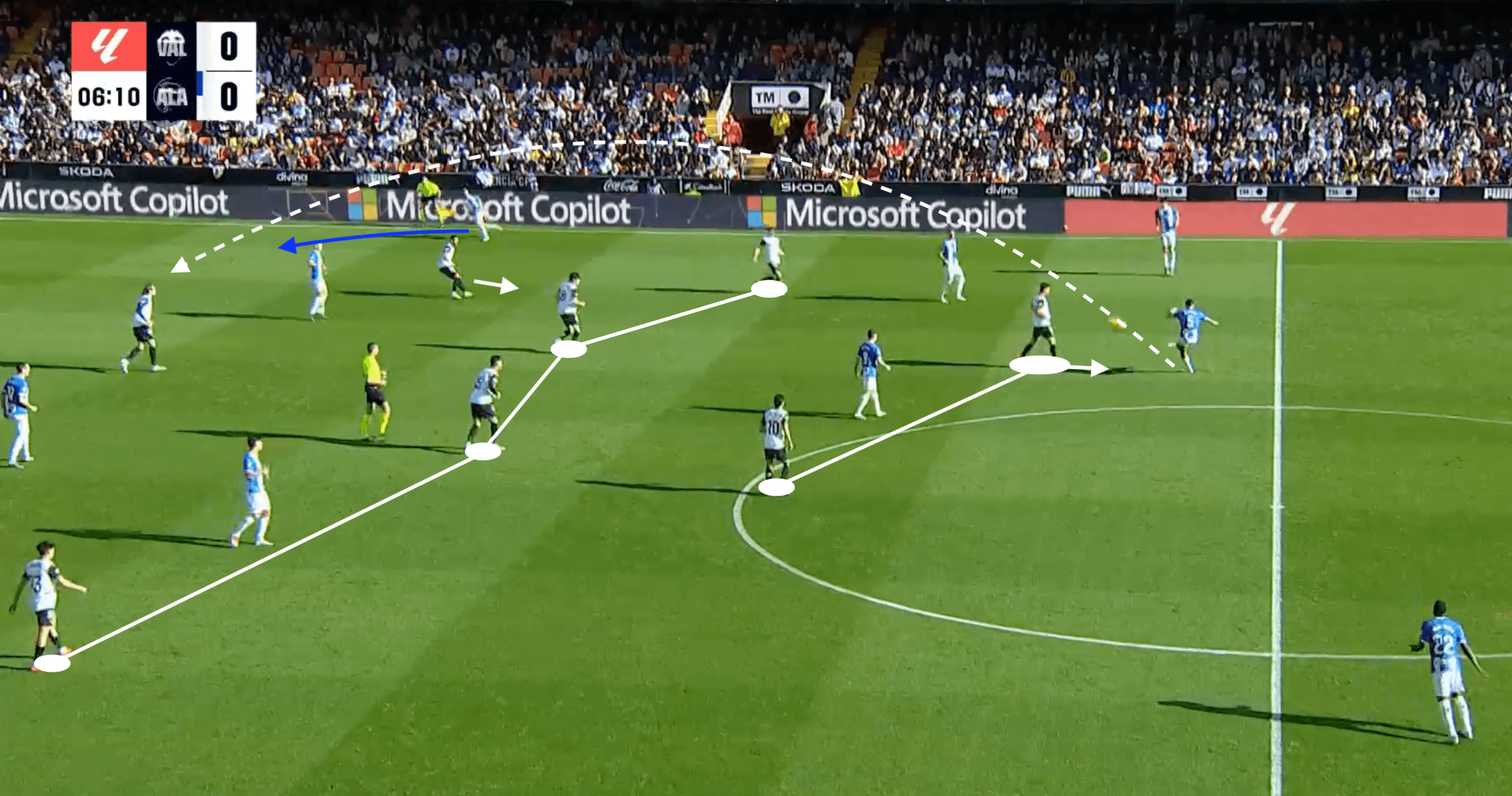
The example above highlights that despite Valencia appearing to shape up in an effective and balanced pressing structure, Hugo Duro’s hesitation and lack of desire allow the Alaves defender enough time and space to exploit the poor positioning of Luis Rioja over the top.
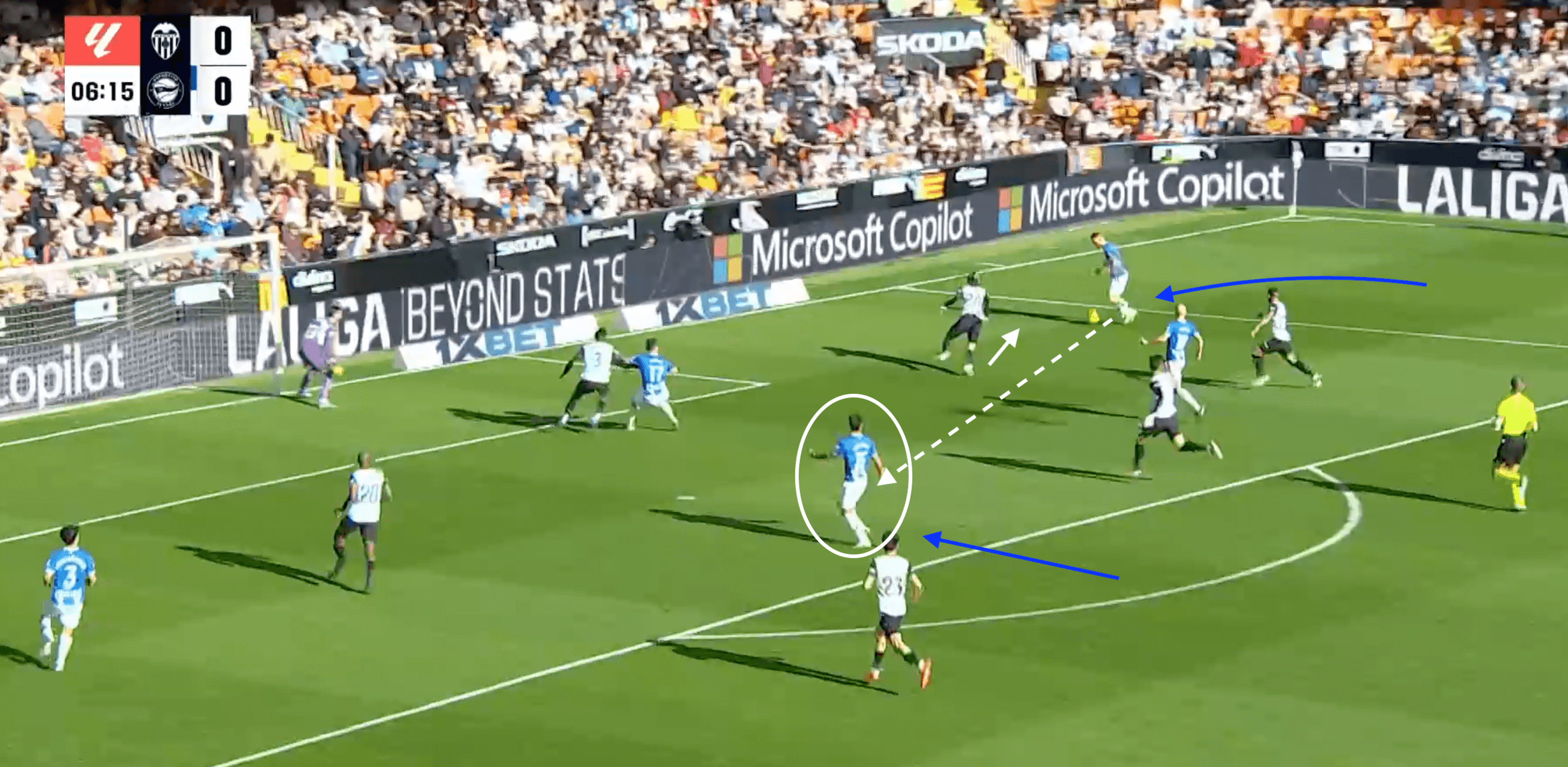
As the sequence transpires and Alaves can threaten out wide in transition, it also magnifies a consistent Valencia weakness that allows a free midfielder to enter the penalty box unopposed, with too much space between the lines to prevent the opposition from getting on the end of the cut-back cross.
Valencia’s full-backs’ positioning has been a huge issue this season.
They are often found to be playing too high and unable to offer any form of rest defence in the event of an opposition counterattack.
Even when starting from a fairly solid 3-man rest defence deep in their own half, we see how the necessity for positional rotations and Pepelu’s forced engagement through the centre allow Espanyol to quickly play towards the flanks, with Foulqiuer struggling to track back and limit the space.
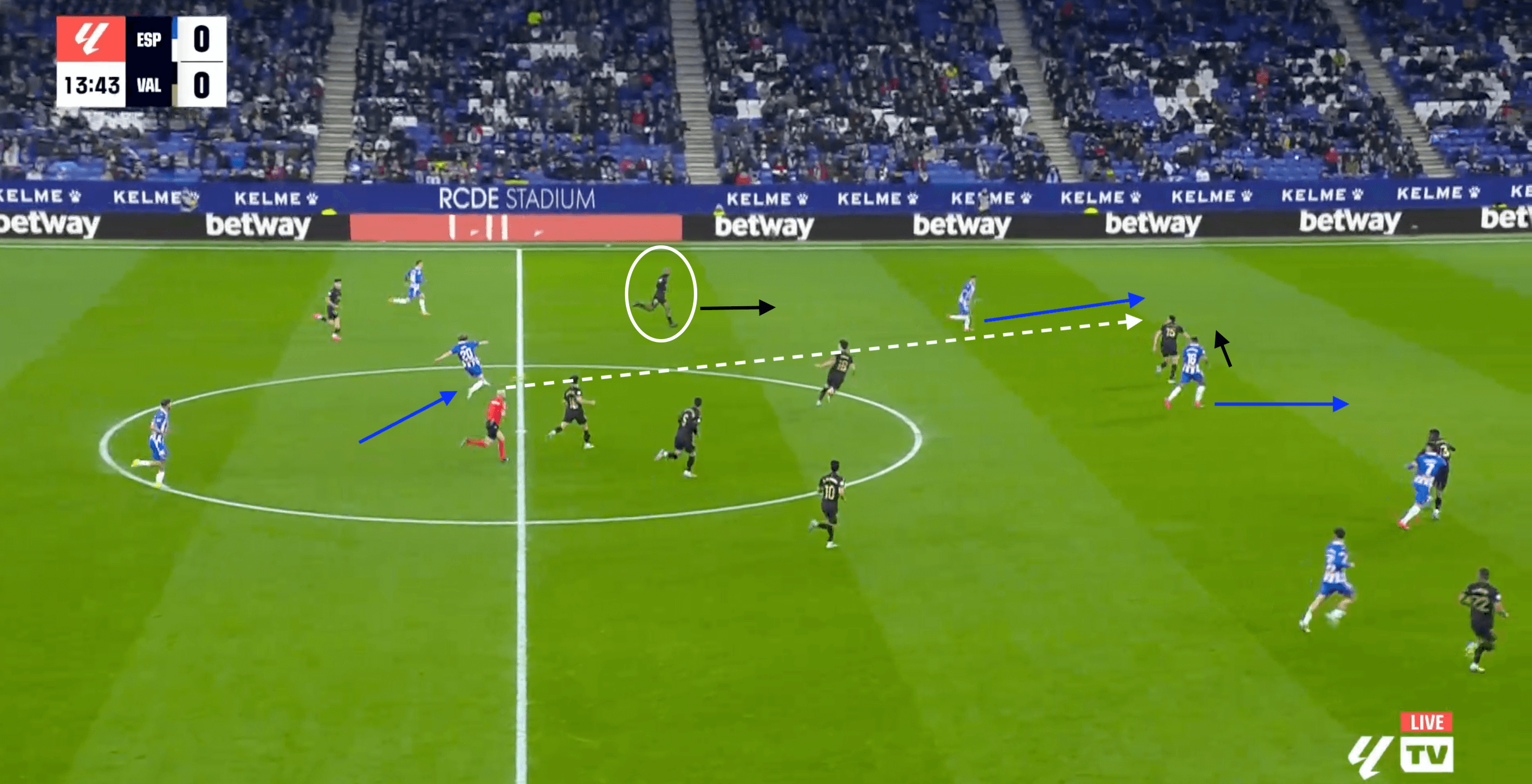
Perhaps the most worrying feature of Valencia’s defence has been the ease at which opponents play through into the final third, often bypassing the midfield altogether.
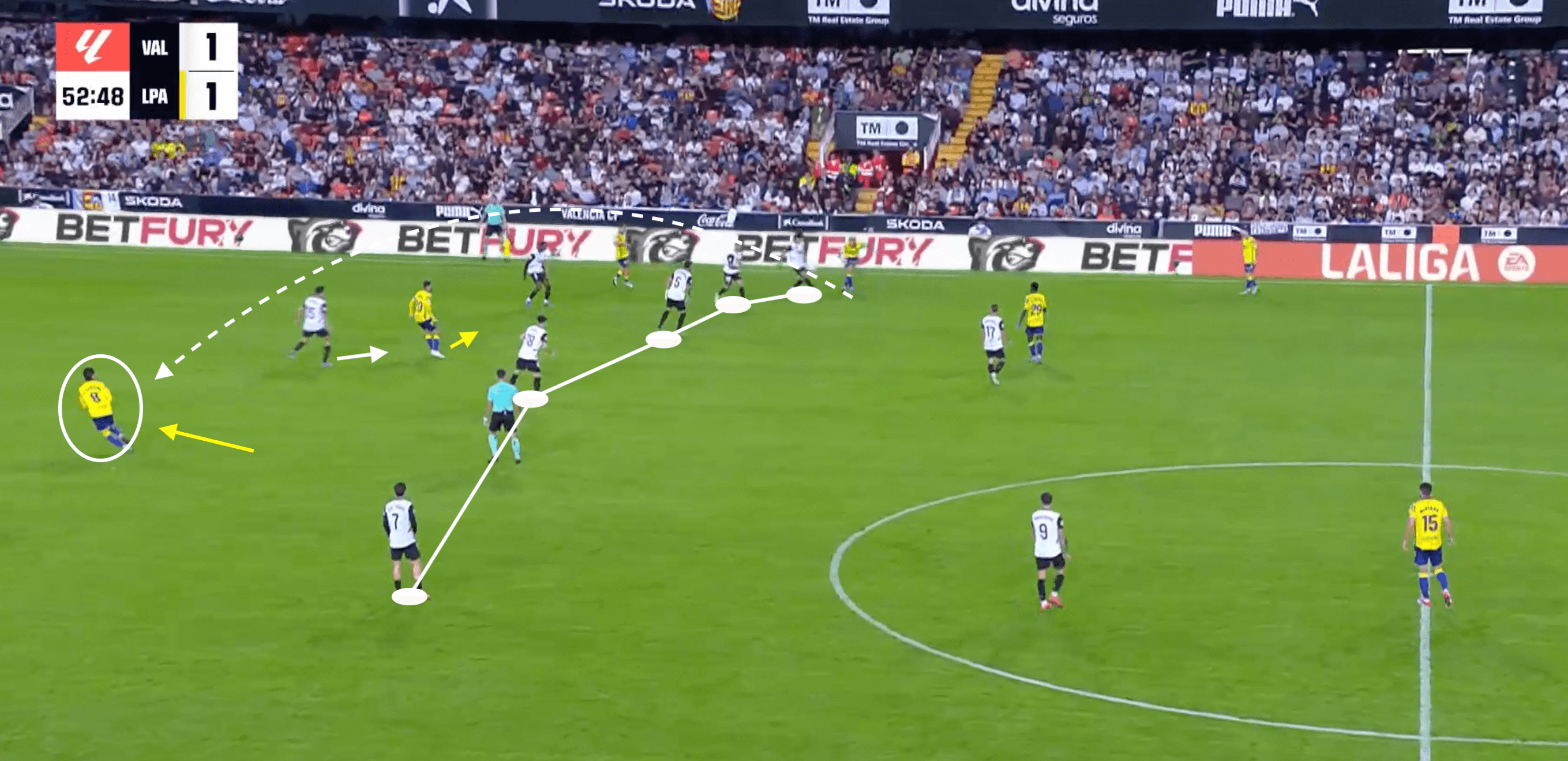
Against Las Palmas, Valencia operated with a clear and well-aligned midfield line, but once again, their defensive style lacked conviction and intent, allowing three Valencia defenders to watch on as the ball was lofted into the final third.
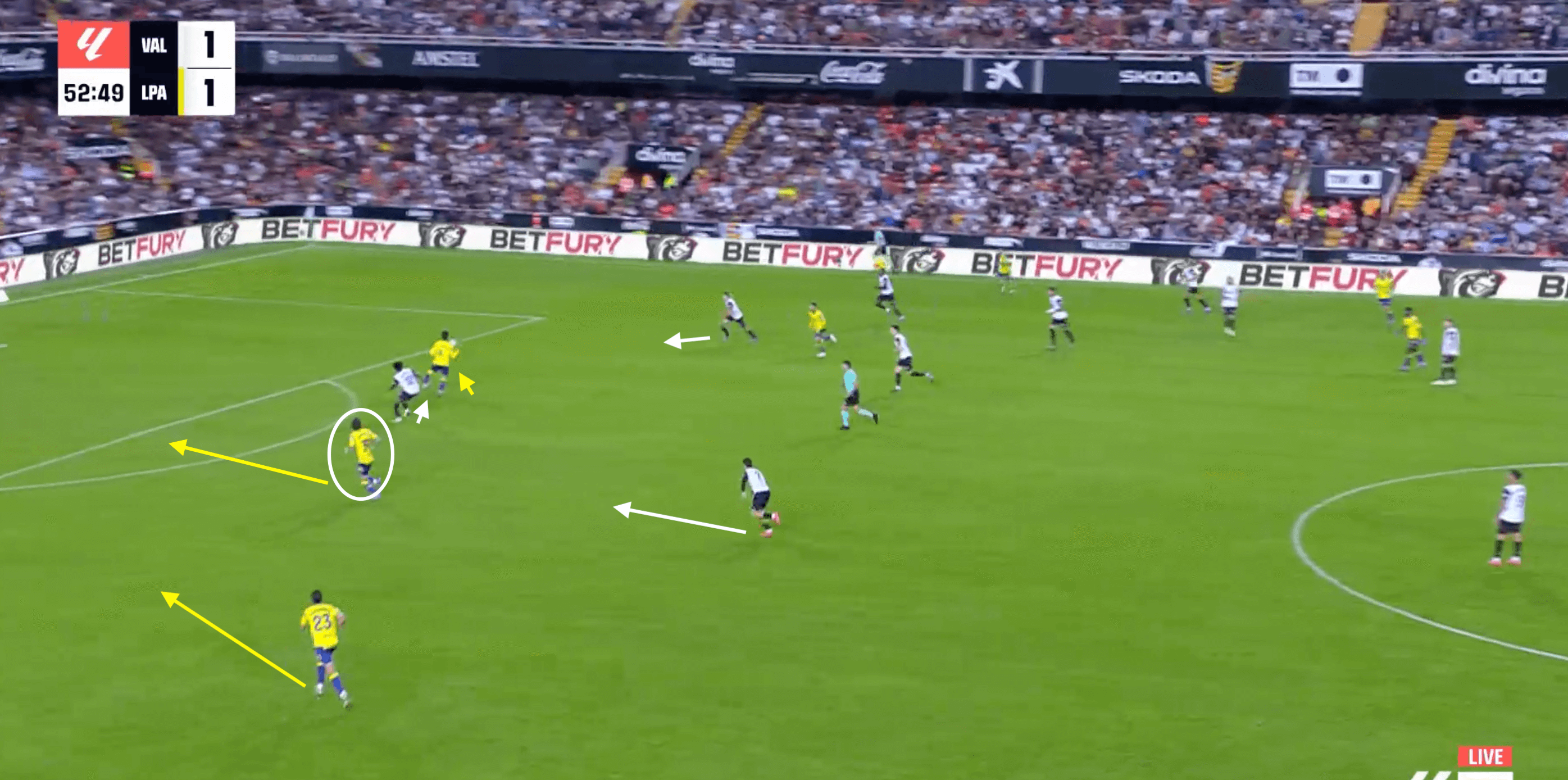
The direct movement of José Campana could then take advantage of Tárrega’s decision to step up, creating a dangerous 1v1 isolation against Correia that allowed Fabio Silva the freedom to enter the penalty area unmarked.
This pattern and trend are certainly interesting as they depict the negative features of Valencia’s season defensively.
This is often due to their confusion and lack of ideas when in possession, further emphasising fans’ cries for a complete stylistic and tactical overhaul.
Valencia’s Stagnating Attack
When analysing their efforts in possession, it is clear to see why fans have grown tired and confused as to why Baraja’s side have failed to impress in front of goal this season.
Valencia has scored 16 goals across 17 matches in LaLiga this season, with an expected goals figure of 16.78 xG (17th in LaLiga).
This suggests that their shortfall cannot necessarily be attributed to poor luck or significant underachievement.
Their mediocre underlying statistics paint an interesting picture of their attacking efforts.
50.15 final third entry passes per 90 would not exactly reflect a team currently perilously close to the foot of the table.
However, Valencia’s issue has been its inability to craft meaningful chances when it reaches these profitable positions, as shown in the chance creation metrics and the following visual examples.
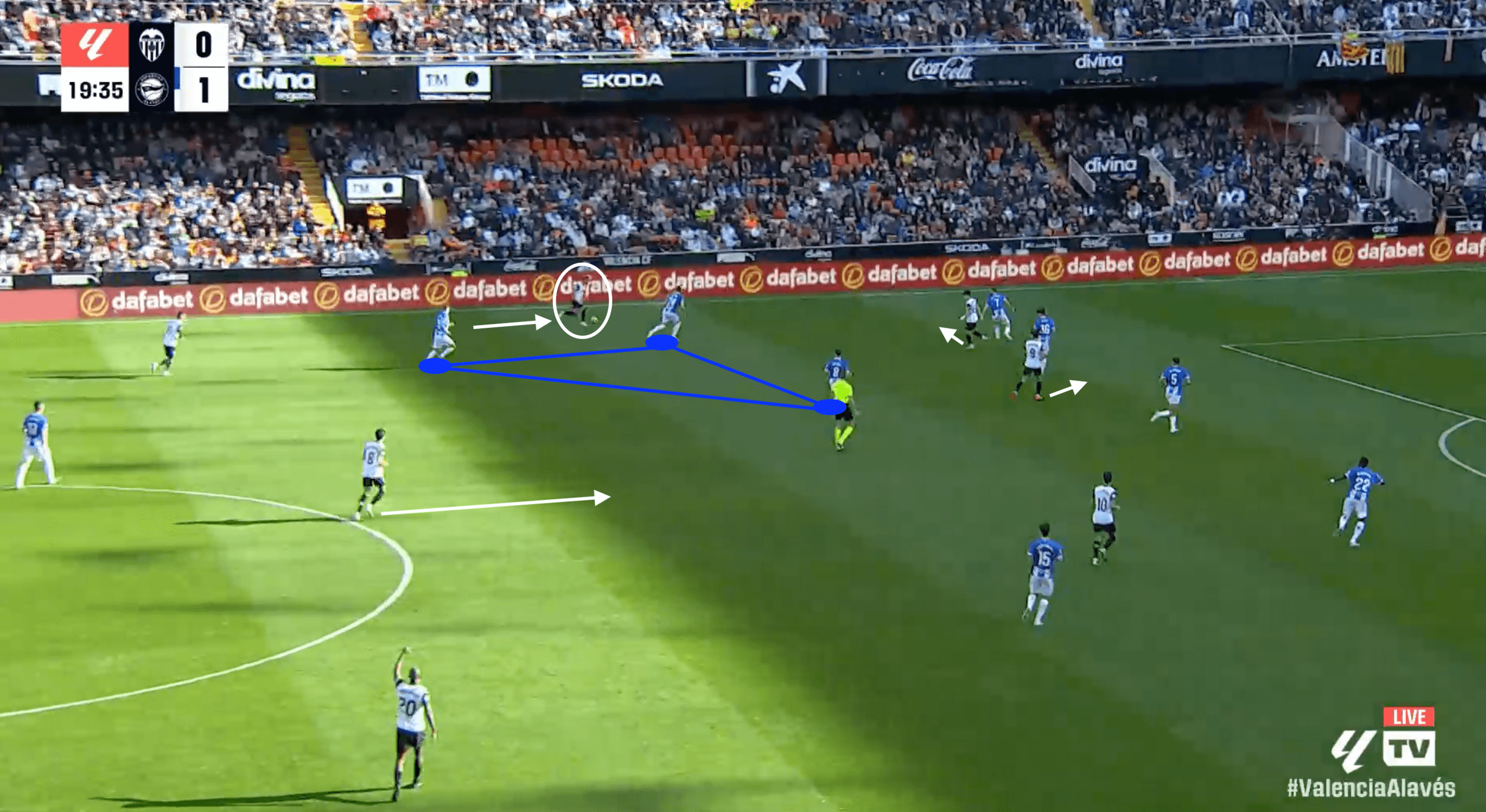
As Valencia progress the ball into the middle and final thirds against Alavés, we see how their attacking shape clearly supports the movement of the ball along the flanks, with minimal interior support and the opportunity to overload the left flank thanks to the advancing left-back.
These instances have allowed Valencia to complete the most crosses into the penalty area per 90 across the entirety of LaLiga this season (18.49), with a clear aim to get the ball into the area at the earliest convenience.
So, while this may appear to be a profitable method of attack for Baraja’s team, their crossing accuracy has lagged behind, at a 31.3% success rate.
Valencia ranks dead last in LaLiga for 1v1 dribble success (48.2%), which means that while the team can, in fact, find opportunities to cross into the penalty area, it is often taken under immense pressure and from sub-optimal locations.
It also raises the question of whether an aerial-first preference suits the profiles of their key forwards, with Hugo Duro ranking within the 42nd percentile for the percentage of aerial duels won (38.3%).
The following example against Valladolid also magnifies Valencia’s poor decision-making within the final third.
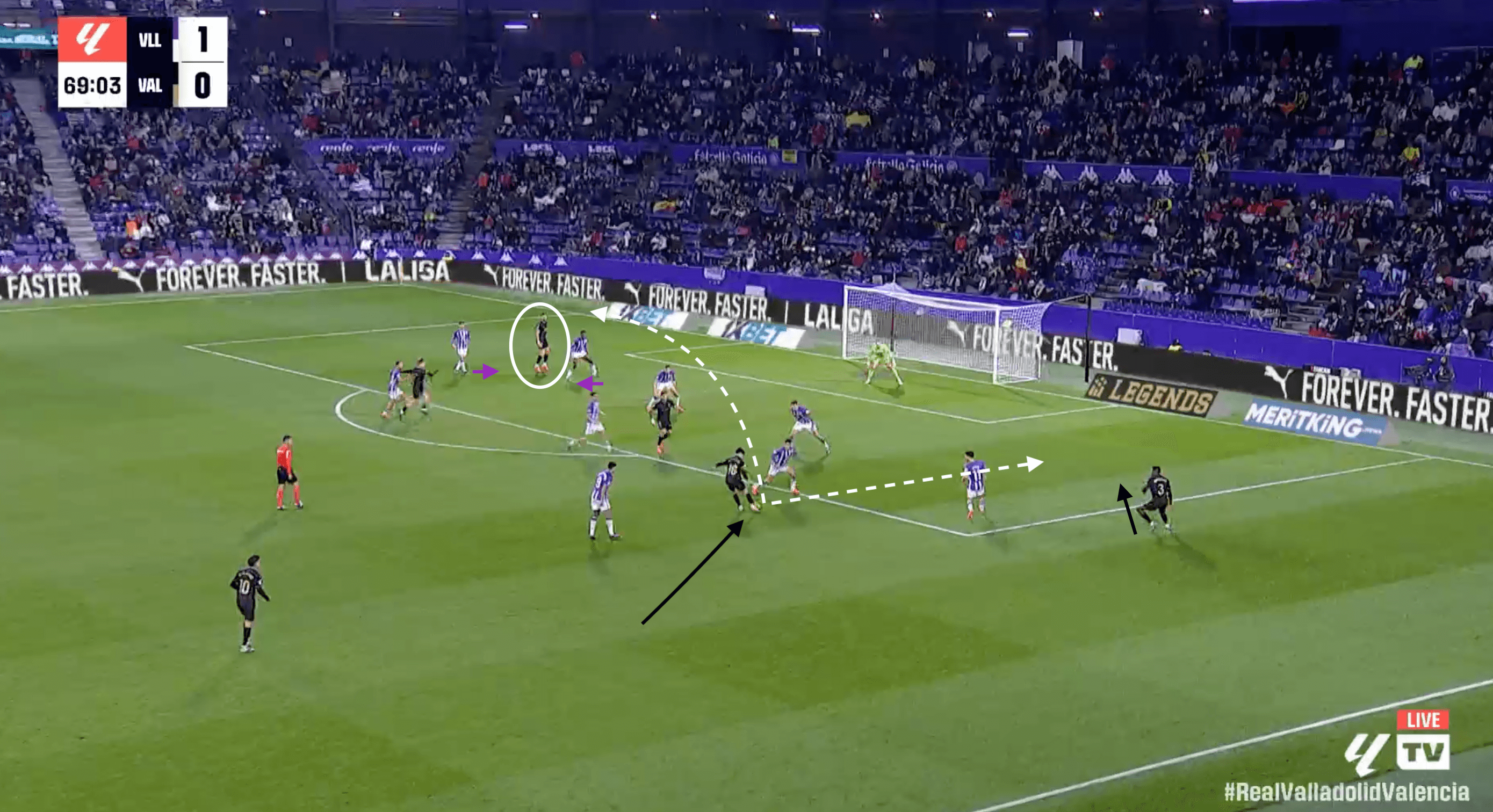
As Diego Lopez approaches the edge of the Valladolid penalty area, we can see that instead of sliding the ball between the central defender and full-back for Foulquier to attack in stride, he opts for an ambitious lofted cross into the double-covered striker.
This fails to unsettle Valladolid’s 5-3-2 defensive structure in a match in which Valencia failed to record a big chance against one of their relegation rivals, further emphasising the detrimental effect of these dropped points.
It is not just how Valencia have impacted the game in the final third that has been disappointing, but also how they build up possession in deeper areas.
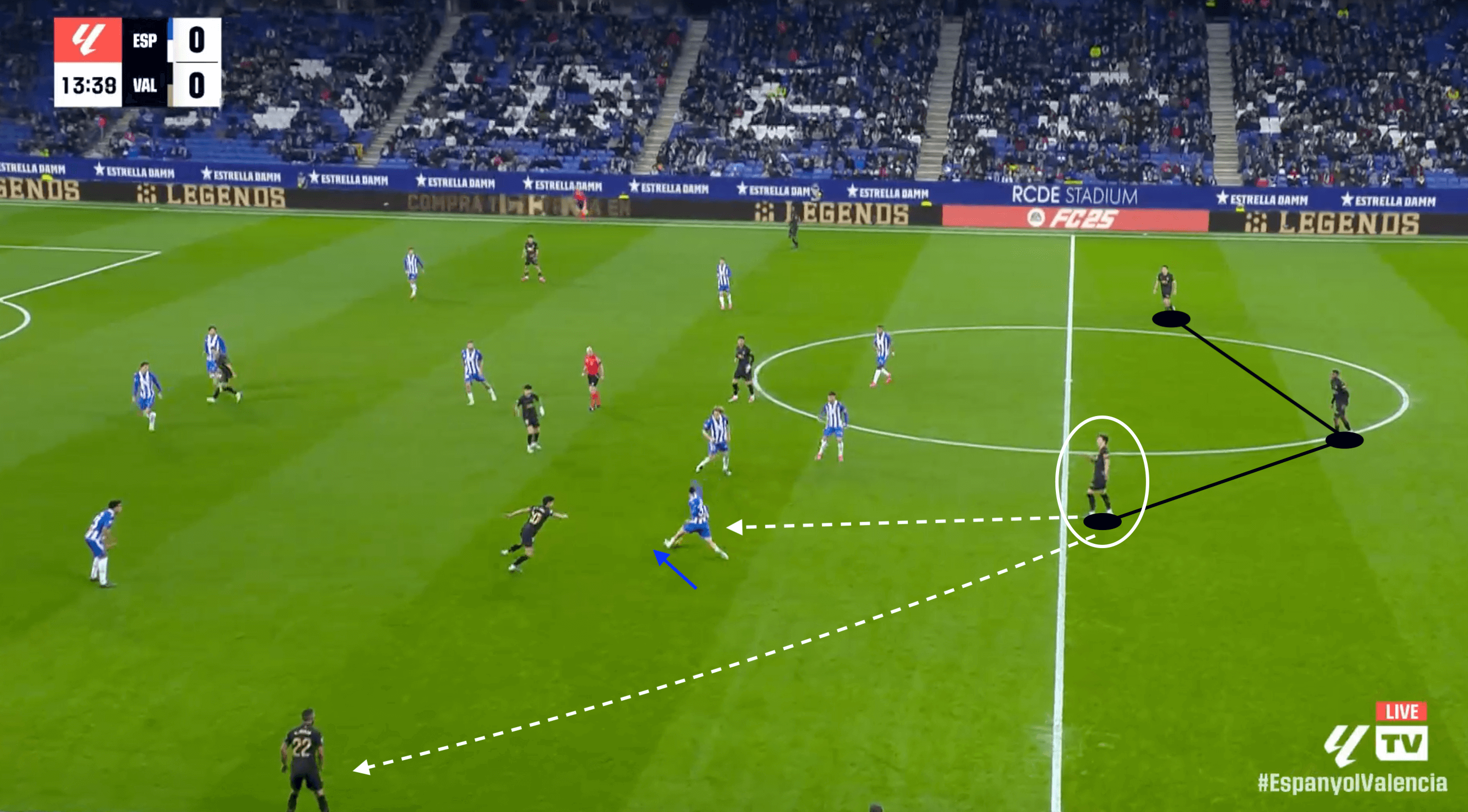
Even when Pepelu dropped deeper to create more of a 3-5-2 against Espanyol, the Spaniard opted to ignore the direct outlet pass to Rioja on the left touchline, instead looking to thread an audacious pass into an already crowded midfield zone.
This has been a feature of Valencia’s play this season, with their midfield often being isolated and overran despite it being their strongest collection of players on paper.
Subsequently, Valencia have looked to perform long passes at a much higher rate than other LaLiga teams (42.4 per 90).
This has been a recipe for more ball losses and situations where the opposition is gifted possession straight back.
Conclusion
For now, Valencia have an excellent opportunity to reassess their playing style under a new manager during the winter break; with Corberán desperate to come in and hit the ground running.
Luckily for Valencia, his time at West Brom would indicate that switching to a more proactive and hungry team style could provide a short-term fix before really aiming to rebuild Los Ches in the long term.
Similar switches to a more attack-minded approach have completely restored faith within other fanbases across Spain.
Diego Martinez reignited the flame at Las Palmas, which started the season similarly to Valencia.
Having analysed the in-possession features of West Brom and Carlos Corberán earlier in the season, it is clear that a Valencia side filled with more attacking dynamism and unpredictability will go a long way towards also relieving some of the glaring issues at their own end of the pitch.
Corberán’s emphasis on isolated wingers should provide Valencia with a solid defensive base and allow them to operate at a much more respectable defensive line height, reducing space that the opposition can exploit.
Coupled with a more risk-averse and coordinated central defensive partnership, Valencia could hopefully find solace in the fact they only have to overcome a 4-point margin to escape the bottom three.
The upcoming transfer window is one of the most influential in recent history for Valencia, but Peter Lim may have already pulled off his most important mid-season acquisition as an early Christmas present for Valencia supporters.

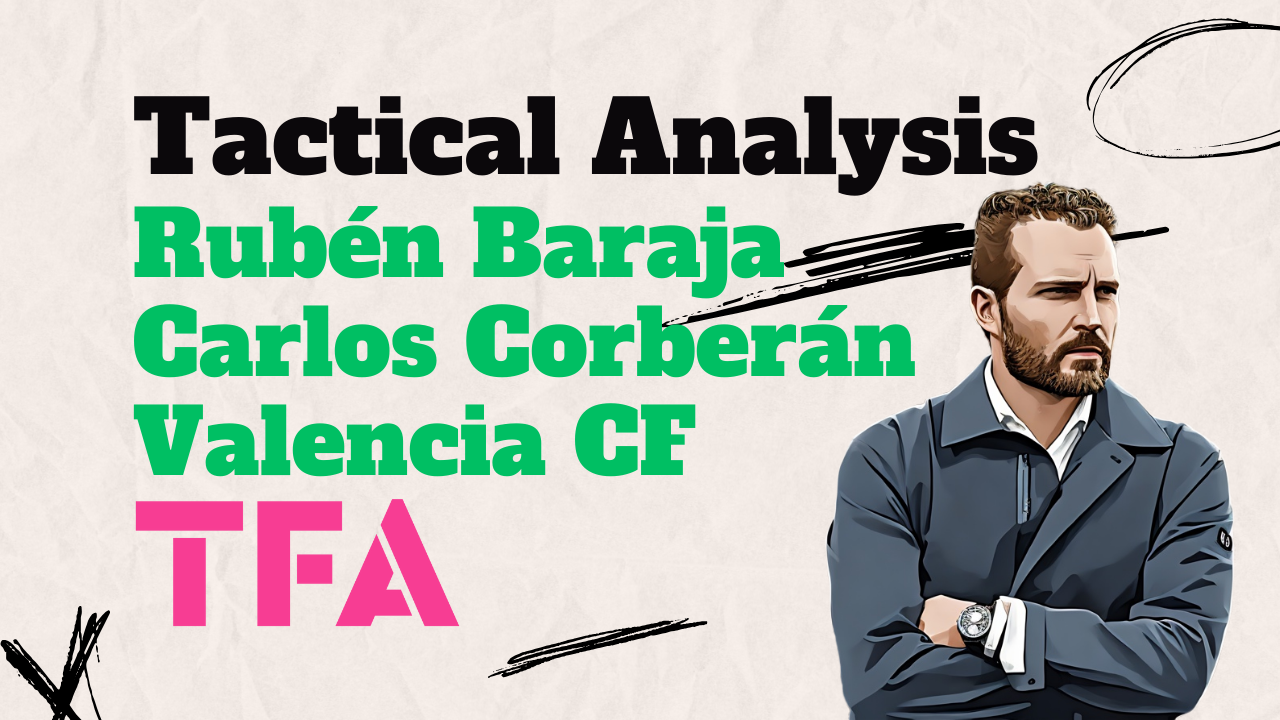



Comments